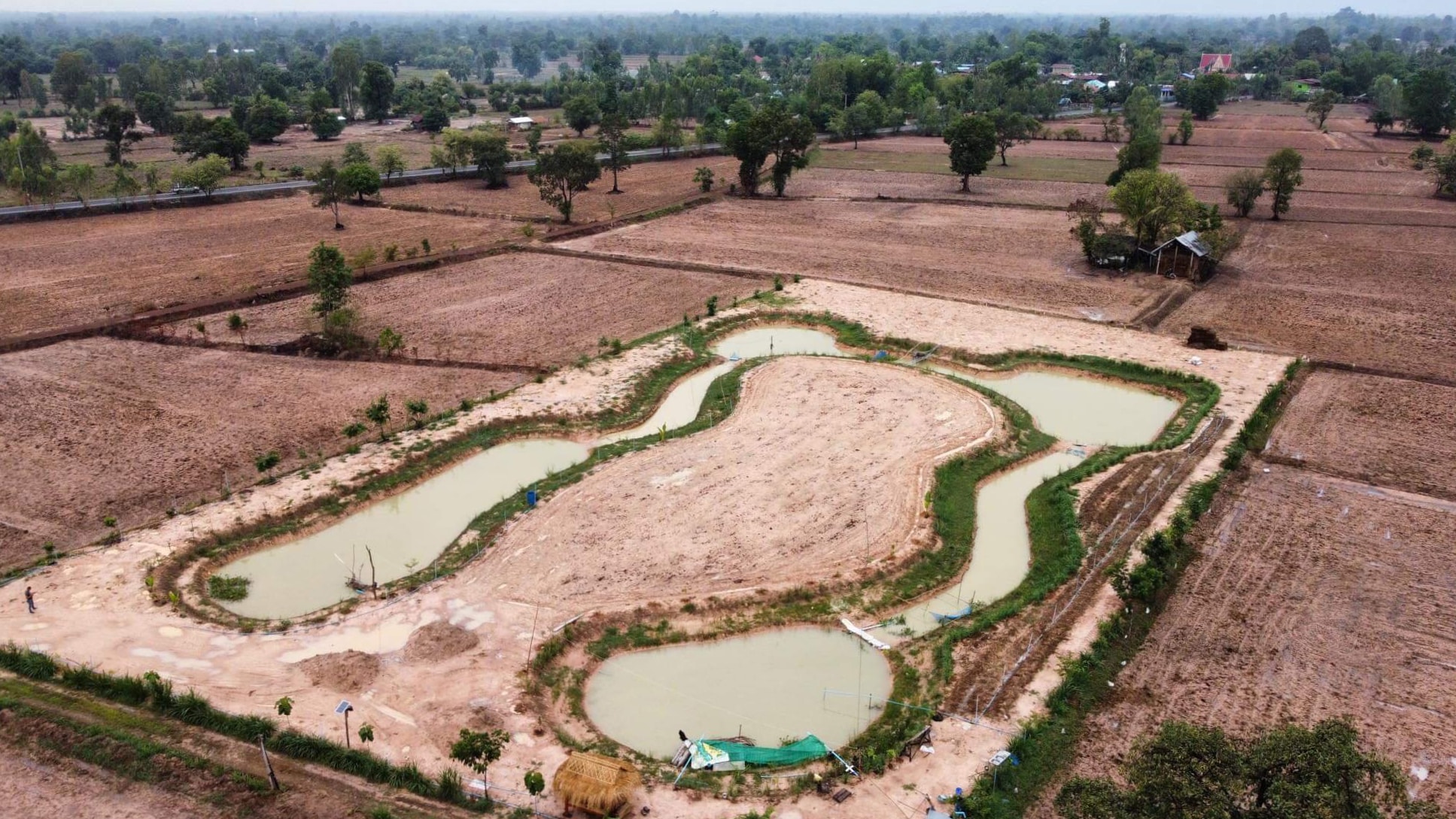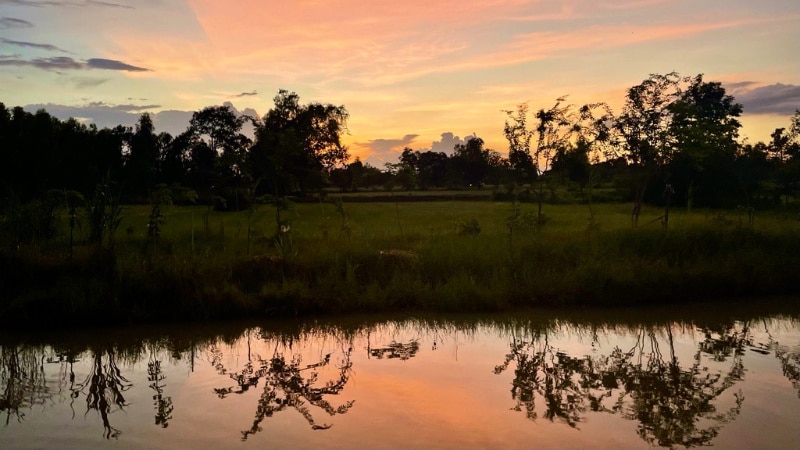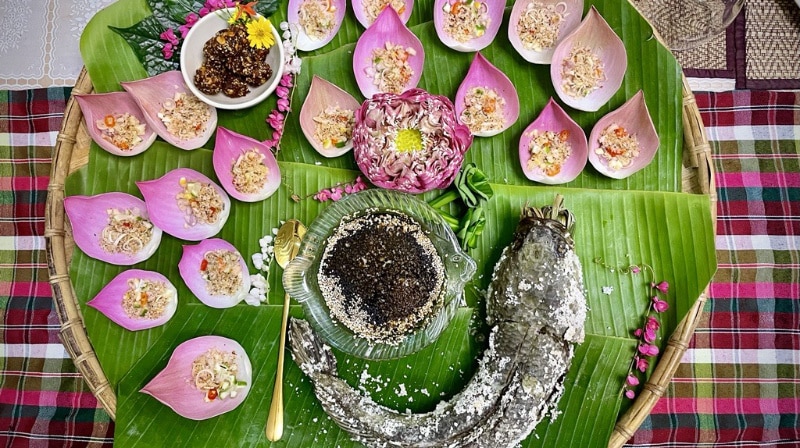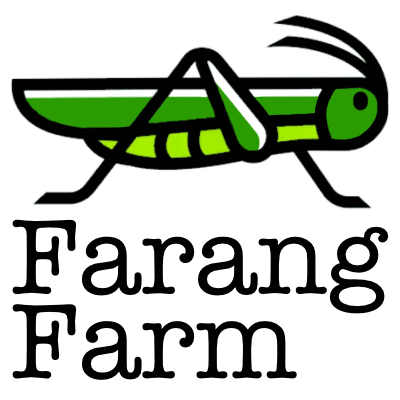What is the Khok Nong Na Model?
The Khok Nong Na Model is an integrated farming system in Thailand, similar to permaculture design and agroforestry. It prioritizes resource conservation, efficient water management and community development.
Inspired by the vision of King Bhumibol Adulyadej (Rama IX), the Khok Nong Na Model’s adaptable approach to agriculture focuses on the 30/30/30/10 self sufficiency principle. It can be passed down through generations, fostering sustainable and resilient agricultural practices for Thai farmers.
30/30/30/10 Principle
The 30/30/30/10 principle guides land and water allocation.
- 30% for rice fields or paddy fields (for staple food production)
- 30% for orchards or mixed gardens (for fruits and vegetables)
- 30% for ponds or water storage (for irrigation and fish farming)
- 10% for residence and livestock (for living and raising animals)

Sustainable farming terminology
Permaculture:
Permanent Agriculture. Food forest. ‘Earth care, people care & fair share.’
Agroforestry:
Combining trees with agriculture to create balance and diversity
Integrated Farming:
Holistic farming methods combining livestock and crop production
Khok Nong Na Key Features
At the heart of the Khok Nong Na Model are several key factors:

1. Land and water management
Similar to permaculture, the Khok Nong Na model conserves and utilises water resources, using the 30/30/30/10 principle. The system connects a network of ponds. The excess soil is used to create elevated mounds. This design prevents flooding in the rainy season and stores water in summer. This approach to water management also improves soil fertility.
2. Crop diversity
A diverse array of crops, including rice, vegetables, fruits and herbs are cultivated within the Khok Nong Na Model. This approach ensures flexibility and bio-diversity. Upfront costs, plus initial income loss, prevent the system from being adopted on a larger scale. However, the ultimate goal of a permaculture style ‘Food Forest’ can outweigh the downsides.


3. Responding to change
This model is designed to evolve with climate change, incorporating new technologies and knowledge along the way. This relates to the permaculture design principle; ‘Creatively use and respond to change’. Bio-diversity acts as a form of insurance against changing weather patterns. In the long term, a diverse food forest is more resilient than monoculture practices.
4. Community growth
The Khok Nong Na model can foster strong community relationships through collaborative activities such as crop planting and marketing products derived from the farm. Our aim is not only to make us profitable, but to inspire our neighbours to join. This doesn’t address the challenges of upfront investment costs and short-term revenue loss, but we believe tackling these issues together will lead to long-term success.


5. Sustainable systems
The Khok Nong Na Model supports a type of agriculture in harmony with the environment. It aligns with the permaculture ethics of earth care, people care & fair share. Benefits include reduced soil erosion, greater biodiversity and carbon sequestration. In the long run, these interconnected sustainable systems contribute to food security, improved livelihoods and a healthier ecosystem.
6. Community-based tourism
The model helps stimulates local tourism by showcasing unique lifestyles, cultural heritage and wonderful Thai food. We can attract eco-conscious tourists interested in learning about sustainable farming and the flavours of Thailand created with organic, local ingredients. Community-based tourism helps generate income, share knowledge about sustainable agriculture and foster cross-cultural understanding.


7. Encouraging education
Education is a vital aspect of the Khok Nong Na Model, as it allows us to demonstrate sustainable agriculture practices. By providing workshops, courses and hands-on experiences, we can empower the next generation to adopt these principles of permaculture, agroforestry, and integrated farming systems. This ongoing process of learning and adaptation ensures that the Khok Nong Na Model can remain relevant and effective for generations to come.
8. Online Marketing and Collaboration
We aim to collaborate with environmentally conscious and community-based organizations. By assisting sustainable initiatives in reaching a larger audience, we hope to be part of a network of like-minded individuals. In turn, we hope to find others who can help us optimise our farm’s potential. This aligns with the model’s focus on community growth and education, as it encourages knowledge-sharing and the adoption of sustainable practices on a broader scale.
This video illustrates how Farang Farm can provide promotional materials to others. If you would like to collaborate, please contact us.
